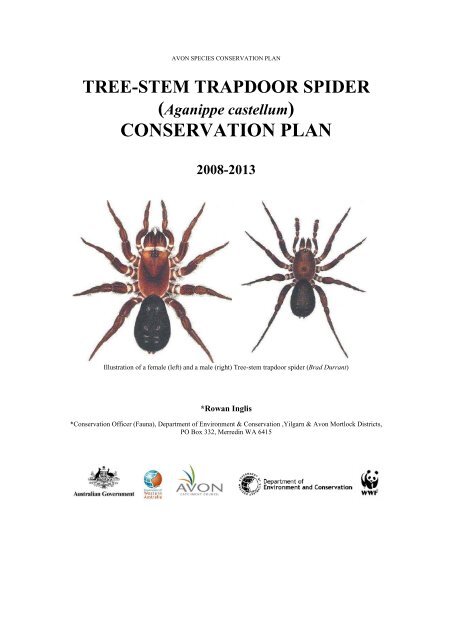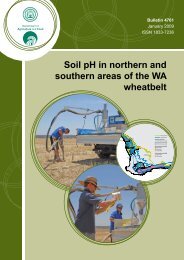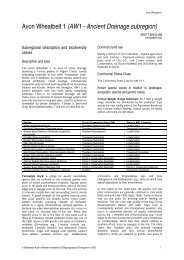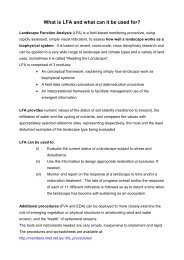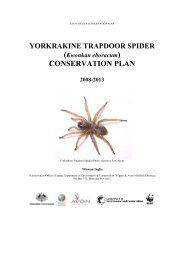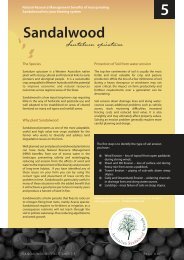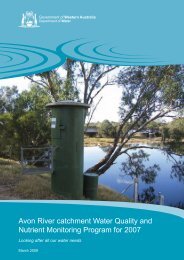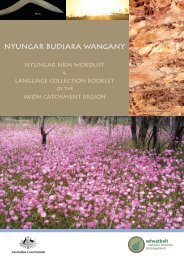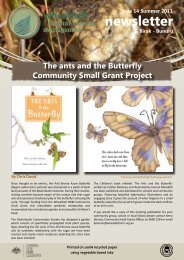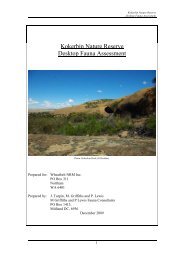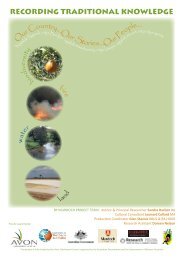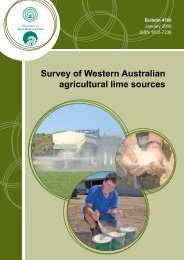Tree-Stem Trapdoor Spider (Aganippe castellum) - Wheatbelt NRM
Tree-Stem Trapdoor Spider (Aganippe castellum) - Wheatbelt NRM
Tree-Stem Trapdoor Spider (Aganippe castellum) - Wheatbelt NRM
You also want an ePaper? Increase the reach of your titles
YUMPU automatically turns print PDFs into web optimized ePapers that Google loves.
AVON SPECIES CONSERVATION PLANTREE-STEM TRAPDOOR SPIDER(<strong>Aganippe</strong> <strong>castellum</strong>)CONSERVATION PLAN2008-2013Illustration of a female (left) and a male (right) <strong>Tree</strong>-stem trapdoor spider (Brad Durrant)*Rowan Inglis*Conservation Officer (Fauna), Department of Environment & Conservation ,Yilgarn & Avon Mortlock Districts,PO Box 332, Merredin WA 6415
CONTENTSSUMMARY.....................................................................................................................................11. INTRODUCTION .....................................................................................................................32. TREE-STEM TRAPDOOR SPIDER ......................................................................................42.1 History and Taxonomic Relationships 42.2 Description 42.3 Distribution, Habitat and Movements 42.4 Biology and Ecology 52.5 Conservation Status 73. HABITAT CRITICAL TO SURVIVAL AND IMPORTANT POPULATIONS…………84. GUIDE FOR DECISION MAKERS .......................................................................................85. THREATS................................................................................................................................105.1 Lack of ecological resources to support viable populations 115.2 Impacts of introduced plants and animals 115.3 Inappropriate fire regimes 125.4 Impacts of competing resource use (Gravel extraction & mining) 135.5 Salinity/Altered Hydrology 136. INTERNATIONAL OBLIGATIONS....................................................................................137. AFFECTED PARTIES ...........................................................................................................148. INDIGENOUS PEOPLE ........................................................................................................149. BENEFITS ...............................................................................................................................1510. SOCIAL AND ECONOMIC IMPACTS.............................................................................1511. CONSERVATION OBJECTIVES AND CRITERIA........................................................1611.1 Conservation plan objective 1611.2 Recovery Criteria 1611.3 Evaluation 1612. CONSERVATION ACTIONS .............................................................................................1612.1 Establish a Mygalomorph Conservation Team 1712.2 Determine the population characteristics of known populations & ongoing monitoring 1812.3 Undertake a threat assessment for each population 1912.4. Address threats to specific populations 1912.5 Conduct surveys to identify new populations 2012.6 Promote public awareness 21iii
13. SUMMARY OF CONSERVATION ACTIONS.................................................................2214. REFERENCES ......................................................................................................................23APPENDICES ..............................................................................................................................24Appendix 1 Summary of population land vesting, purpose and tenure (extant populations) 24Appendix 2 Extant Mygalomorph populations associated with mining tenements 25iv
SUMMARY<strong>Tree</strong>-stem trapdoor spider <strong>Aganippe</strong> <strong>castellum</strong> Main 1986Family:<strong>NRM</strong> Regions:Current status of taxon:Idiopidae.Avon, Northern Agricultural Region.Endangered.Description:The <strong>Tree</strong>-<strong>Stem</strong> <strong>Trapdoor</strong> <strong>Spider</strong> is a medium-sizedspider, dark brown to black in colour, and has largeanterior lateral eyes that project beyond the edge of thecarapace (Burbidge, 2004). The length of the carapaceranges from 6.8-8.8mm and the width ranges from 5.2-6.2mm (Main, 1986).Females are distinguished by thorn-like spinules whichcover the labium, sternum, anterior edge of thecarapace, membranous margin of the carapace and arealso found in the foveal crevice (Figure 1). Theabdomen is hirsute and the internal genitalia broadbased.Males have marginal spines on the carapace, thetarsi lack spines, and the palpal tarsus possesses aboutsix apical spines. The embolus has a narrow flange andsharp, subterminal ventral projection, with dorsal spineson the abdomen (Main, 1986).Breeding habitat:Feeding habitat:Burrows in flood-prone depressions, and flats thatsupport myrtaceous shrub communities.Catches prey on stem of burrow located at the base ofthe “host” plant.Habitat critical for survival:The habitat critical to survival of important populationsof A. <strong>castellum</strong> consist of flood-prone depressions andflats which support myrtaceous shrub communities. Inparticular, those areas supporting Broombush(Melaleuca uncinata) and Sheoaks (such asAllocasuarina acutivalvis) in sandy loam soils arecritical to the survival of this species1
Conservation plan objective:To maintain, and if possible enhance, the condition of insitu populations of <strong>Aganippe</strong> <strong>castellum</strong>.Recovery Criteria:Criteria for success:The number of populations has increased and/or the number of mature individuals hasincreased by fifteen percent or more over the term of the plan.Criteria for failure:The number of populations has decreased and/or the number of mature individuals inthe known populations has decreased by fifteen percent or more over the term of theplan.Conservation Actions:1. Establish a Mygalomorph Conservation Team2. Determine the population characteristics of known populations & ongoingmonitoring3. Undertake a threat assessment for each population4. Address threats to specific populations5. Conduct surveys to identify new populations6. Promote awarenessConservation Team:The formation of a Mygalomorph Conservation Team isrecommended as part of this and other Mygalomorphconservation plans.Conservation plan time frame:This plan will be1 implemented, updated andcontinually evaluated over a 5 year period from 2008 -2013.1 The degree of implementation will depend on the availability of future funding and resources.2
1. INTRODUCTIONThe <strong>Tree</strong>-stem <strong>Trapdoor</strong> <strong>Spider</strong> (<strong>Aganippe</strong> <strong>castellum</strong>) belongs to the suborderMygalomorphae, commonly known as “<strong>Trapdoor</strong>” and “Funnel-web” spiders. Theyare primarily terrestrial burrowing spiders which occasionally make tubular silk nestson tree trunks. Mygalomorphs are able to persist in small isolated areas due to theirlow dispersion powers, long life cycle and sedentary life style (Main, 1987a).Mygalomorph spiders take several years to reach reproductive maturity, and femalescan live up to and exceeding twenty years. Mature males leave their burrows duringmoist conditions in search of females, and die shortly after mating (Main, 1985, Yen& Butcher, 1997). Females lay their eggs in a silk cocoon in the burrow, and afterspending several months confined to the parent burrow, spiderlings emergeapproximately one year after the parental mating (Main, 1982).In areas that experience drought, mygalomorph spiderlings disperse from theirmother’s nest during or following rainy weather, and establish a new burrow in rainsoftenedsoil. During this process, juveniles are vulnerable to predation by birds,mammals, lizards, frogs and other arthropods (Main, 1985).Predators of A. <strong>castellum</strong> include other arthropods (eg. Centipedes and Scorpions)which enter burrows, Goannas and Bandicoots which dig out burrows and PompilidWasps, some of which specialize in preying upon burrowing spiders (Main, 1985). Amajor threat to A. <strong>castellum</strong> includes the loss or alteration of habitat due to theirspecialized habitat requirements, which may restrict them to microhabitats that haveonly subtle differences to adjacent ones. As a result, physical disturbance to thesemicrohabitats can cause local extinction of populations (Main, 2002).3
2. TREE-STEM TRAPDOOR SPIDER ECOLOGY AND LIFE HISTORY2.1 History and Taxonomic RelationshipsThe <strong>Tree</strong>-<strong>Stem</strong> <strong>Trapdoor</strong> <strong>Spider</strong>, (<strong>Aganippe</strong> <strong>castellum</strong>) was first identified by BarbaraMain in 1986. The species name <strong>castellum</strong> is translated from Latin to mean ‘fortress’or ‘tower’, describing the above-ground burrow structure which distinguishes thisspecies from other trapdoor spider species.Any cross-breeding with other spider species is unknown, but thought to be unlikelydue to the morphological distinction of this species and the short dispersal distance ofoffspring from the parent burrow.2.2 DescriptionA. <strong>castellum</strong> is a medium-sized spider, dark brown to black in colour, and has largeanterior lateral eyes that project beyond the edge of the carapace (Burbidge, 2004).The length of the carapace ranges from 6.8-8.8mm and the width ranges from 5.2-6.2mm (Main, 1986).Females are distinguished by thorn-like spinules which cover the labium, sternum,anterior edge of the carapace, membranous margin of the carapace and are also foundin the foveal crevice (Figure 1). The abdomen is hirsute and the internal genitaliabroad-based. Males have marginal spines on the carapace, the tarsi lack spines, andthe palpal tarsus possesses about six apical spines. The embolus has a narrow flangeand sharp, subterminal ventral projection, with dorsal spines on the abdomen (Main,1986).2.3 Distribution, Habitat and MovementsThere are currently 22 known populations of A. <strong>castellum</strong> which have an extent ofoccurrence of approximately 25,000 km 2 (determined by enclosing knownpopulations in a spatial polygon). The area of occupancy is likely to be considerablysmaller due to the short dispersal distances of offspring. It is thought that eachpopulation occupies no more than 1 km 2 and has an abundance ranging from 6 to 190individuals (Russell, 2006).4
Figure 1: Photograph of a female <strong>Tree</strong>-stem trapdoor spider. (Photo: Monica Russell)The 22 known populations of A. <strong>castellum</strong> occur in the south-west of WesternAustralia. They extend to the north as far north as Pintharuka Nature Reserve(Morawa Shire), south to the Merredin townsite, and east to Southern Cross (Figure2). The population at Pintharuka is the only known population that exists outside ofthe Avon Catchment Council (ACC) <strong>NRM</strong> (Natural Resource Management)Boundary. Details regarding the location, tenure, population size and date of lastonsite monitoring etc for each known population are included in Appendix 1.A. <strong>castellum</strong> prefer habitats in flood-prone depressions and flats that supportmyrtaceous shrub communities. The burrows of this species are specially designedwith an aboveground entrance to withstand occasional sheet flooding (Main, 1987a).2.4 Biology and EcologyA. <strong>castellum</strong> live in individual nests throughout their entire lives. The nests structureof A. <strong>castellum</strong> is unique to this particular species. These spiders generally build theirnests against the stems of trees such as broombush (Melaleuca uncinata), Sheoaks(such as Allocasuarina acutivalvis) and other Myrtaceous shrubs in sandy loam soils(Freegard, 2003).5
The silk lining of the burrow extends up out of the ground and attaches to the tree orshrub (Figure 3), with the rim facing up the stem and the door opening away from thestem (Main, 1986, Burbidge, 2004). Attached to the rim is a fan of twig-lines whichhang down to the ground and act to direct prey (primarily ants) past the opening of theburrow (Main, 1986).Figure 2. Locations of known populations of <strong>Tree</strong>-<strong>Stem</strong> <strong>Trapdoor</strong> <strong>Spider</strong>s (A. <strong>castellum</strong>) in south-west WesternAustralia. The red points represent the GPS localities of the twelve populations, the blue line marks the AvonCatchment Council <strong>NRM</strong> Boundary, and the brown divisions show the different IBRA (Interim BiogeographicalRegionalisation of Australia) subregions.Female <strong>Tree</strong>-stem <strong>Trapdoor</strong> <strong>Spider</strong>s spend their entire lives in the same burrow, whilemales leave their burrows during winter months to search for females and breed(Burbidge, 2004). These spiders are estimated to live for approximately twentyyears and take several years to mature. <strong>Spider</strong>lings do not disperse far from themothers burrow and cannot move between vegetation remnants (Burbidge, 2004).6
As this species is dependent on the underlying moisture of the soil, changes in thehydrology of an area can significantly affect the survival of this species. An exampleof this occurred at the North Bungulla Nature Reserve and Heitman’s Scrub sites(both sites occur within the Shire of Tammin), where an upslope quarry caused a shiftin the drainage and caused the total mortality of emergent juveniles at these twolocations (Main, 1987b).Figure 3. Typical burrow of <strong>Tree</strong>-stem <strong>Trapdoor</strong> <strong>Spider</strong> (Photo: M. Davis / WWF)2.5 Conservation StatusThe <strong>Tree</strong>-stem <strong>Trapdoor</strong> spider (A. <strong>castellum</strong>) is listed under the Western AustralianWildlife Conservation Act 1950 as Schedule 1 Fauna (fauna that is rare or likely tobecome extinct), and is ranked as Endangered under the World Conservation Union(IUCN) Red list criteria A2c.7
3. HABITAT CRITICAL TO SURVIVALHabitat means the biophysical medium or media: (a) occupied (continuously,periodically or occasionally) by an organism or group of organisms; or (b) onceoccupied (continuously, periodically or occasionally) by an organism, or group oforganisms, and into which organisms of that kind have the potential to bereintroduced (Environment Protection and Biodiversity Conservation Act 1999).Habitat critical to survival and important populations of <strong>Tree</strong>-stem <strong>Trapdoor</strong> <strong>Spider</strong>scomprises:• Areas currently occupied by the spiders;• Areas not currently occupied by the spiders, but adjacent to areas that arecurrently occupied by the spiders;• Areas of suitable vegetation within the recorded range in which undiscoveredspider populations may exist and; and• Areas of suitable habitat previously occupied by A. <strong>castellum</strong>, but that arecurrently unoccupied.The habitat critical to survival of important populations of A. <strong>castellum</strong> consist offlood-prone depressions and flats which support myrtaceous shrub communities, andin particular those areas supporting Broombush (Melaleuca uncinata) and Sheoaks(such as Allocasuarina acutivalvis) in sandy loam soils.4. GUIDE FOR DECISION MAKERSThe availability of accurate data of known A. <strong>castellum</strong> populations and sites with ahigh prospect of supporting A. <strong>castellum</strong> populations is essential to decision-making.Section five provides details of current and potential threats to A. <strong>castellum</strong>. Anyground disturbance works (clearing, firebreaks, road works involving roadsidevegetation or changes to drainage, burning, drainage etc) in the immediate vicinity ofknown A. <strong>castellum</strong> populations will require assessment. Proponents shoulddemonstrate that the work will not have an impact on this species.8
Ground disturbance or other operations which may have a direct or indirect impact onthe habitat or hydrology of known A. <strong>castellum</strong> population will require anEnvironmental Impact Assessment (EIA) to ensure that the species is not adverselyaffected. A pre-disturbance survey to determine the presence / absence of A.<strong>castellum</strong> in habitat that may reasonably be expected to contain an A. <strong>castellum</strong>population is encouragedEncouraging landowners / managers to conserve populations occurring on theirproperties is critical to the protection of these populations. When a new population isidentified on private property, the land owner will be contacted in person by DECstaff to discuss the management needs of the A. <strong>castellum</strong> populations as well as anyconcerns the owner may have. A letter will be provided to the land owner as a formalnotification of the presence of the population and a request to advise DEC of anychange in ownership.Working closely with landowners will improve the capacity to identify and addressany land use related threats.Where the land manager is a local or state government authority, the letter will requirethe agency to implement measures to ensure that the population will not be adverselyaffected by land use. These measures will include advising DEC of any land use thatmay impact on the survival of the population.The DEC provides advice on the location and protection of threatened species andcommunities to telecommunication, water and power providers to ensure that theseareas are managed as Environmentally Sensitive Areas (ESA). DEC will ensure thisadvice includes information on the relatively immobile nature of these fauna species.The DEC is responsible for assessing notifications of intent to clear under the clearingof native vegetation provisions of the Environmental Protection Act 1986. Thisprocess considers the potential impact of the proposed work on threatened faunaspecies.9
DEC also provides advice to the Commissioner for Soil and Land Conservation inrespect to notifications of intent to drain and the potential impact that these proposalsmay have on threatened species and other conservation values.The sedentary nature of these species increases their vulnerability to disturbance.Therefore a Regulation 15 license to take fauna for educational or public purposes isrequired if disturbance will occur in or immediately adjacent to these populations.Applications for this license are made through the Department of Environment andConservation. Failure to obtain a license may result in a breach of the WildlifeConservation Act 1950.5. THREATSA. <strong>castellum</strong> possess certain characteristics that make them more susceptible to threatsthan other wheatbelt fauna. These include poor dispersal capabilities, confinement todisjunct habitats and low fecundity. These characteristics require a similarmanagement approach to the conservation actions undertaken for Declared RareFlora.The limited knowledge of the ecology of this species and the nature of individualpopulations restricts the capacity to conserve these species. The implementation ofthe conservation actions described in section 12 of this plan will address thisknowledge gap and the threats to the survival of this species.The main threatening processes (not necessarily in order of priority) are:1. Lack of ecological resources to support viable populations,2. Impacts of introduced plants and animals,3. Inappropriate fire regimes,4. Salinity/altered hydrology,5. Impacts of competing land use (mining).These threats singularly and collectively contribute towards reduced ecologicalviability of populations and their habitats.10
5.1 Lack of ecological resources to support viable populationsLack of ecological resources to support viable populations relates to the:• Availability of basic resources for survival & reproduction, where availabilityof food, shelter and access to mates limits population size. The survival ofpopulations can be directly threatened when restricted gene flow andinsufficient habitat are below the levels necessary to maintain a viablepopulation.• Restricted gene flow and insufficient habitat can increase a population’ssusceptibility to other threats. Example a small remnant may be totallyconsumed by fire providing no available habitat for the species to persist inbefore the affected habitat returns to suitable pre-fire condition.Land clearing associated with agriculture, mining and infrastructure has resulted inhabitat loss and fragmentation of habitat which in turn results in the lack of ecologicalresources available to support viable populations.Habitat fragmentation reduces the capacity of the species to increase population size,restricts gene flow through preventing the movement of individuals and makes thepopulation more susceptible to other disturbance events. It is likely that the highlyfragmented landscape of the Western Australian wheatbelt, may account for thelimited occurrence of this species.5.2 Impacts of introduced plants and animalsIntroduced animal species have the capacity to cause local extinctions of A. <strong>castellum</strong>populations. Grazing by livestock results in compaction of the soil and a reduction inleaf litter, which affects the ability of the spiders to burrow and forage. Livestock canalso cause direct damage to burrows and their entrances (Main, 2001).11
Grazing by rabbits causes a reduction in the ground cover that is necessary for thesurvival of this spider species. Rabbits may also disturb the soil profile in somespider habitats, and their diggings can directly destroy trapdoor spider burrows(Burbidge et al., 1999).Invasion by introduced plant species cause a change in the structure of vegetationcommunities, which in turn may affect the survival of A. <strong>castellum</strong>.5.3 Inappropriate fire regimesFire represents a direct threat to A. <strong>castellum</strong> as intense wildfires have the capacity toresult in direct mortality to individuals. Fire also represents an indirect threat throughthe reduction in the ground litter required for reconstructing burrows and to supportthe litter-dependant invertebrate food source for A. <strong>castellum</strong>.The ecological functions of fire include: removing competition, making light /nutrients available, reduces levels of parasites, triggering seed release / germinationand maintains balance and diversity of the various components of flora communities.While fire regimes provide a number of important ecological functions, inappropriatefire regimes may threaten the survival of A. <strong>castellum</strong> populations.Inappropriate fire regimes relate to:• Frequency Fires that are too frequent or too infrequent• Season Fires occurring when a species is particularly vulnerable• Intensity Fires are too intense resulting in high mortality• Spatial Fires are too large resulting in no unburnt refuge areas12
5.4. Impacts of competing resource use (Gravel extraction & mining)Mining and gravel extraction represents a threat to known A. <strong>castellum</strong> populationseither directly (destruction of habitat/burrows) or indirectly (nearby mining causing achange in hydrological cycles). Several extant populations of A. <strong>castellum</strong> occurwithin or in close proximity to mining tenements and gravel pits (for full details seeAppendix 2).Areas subjected to mining and gravel extraction are sometimes used as waste disposalsites (official and unofficial). This practice constitutes a further threat throughincreased fire risk, creation of harbourage for invasive species and chemicalcontamination via disposal of pesticide and herbicide containers that may containresidues of contracted chemicals.5.5 Salinity/Altered HydrologySalinity and changes in hydrology (surface and ground water) are threats to A.<strong>castellum</strong> due to the effect they have upon habitats. Both salinity and alteredhydrology can cause changes in vegetation structure and soil composition, which canaffect the ability of A. <strong>castellum</strong> to forage, burrow and breed. Inundation of theupper soil profile through flooding or rising ground water may result in burrowsbecoming waterlogged and unusable.Events such as climate change and changes in the local hydrology of an area(resulting in a drying or excessive wetting of the habitat) must be considered asthreats. The impact of surface and ground water management proposals on A.<strong>castellum</strong> populations needs to be considered. Similarly it may be necessary toimplement surface and or ground water management to conserve known populationsthreatened by altered hydrology.6. INTERNATIONAL OBLIGATIONSThe <strong>Tree</strong>-stem <strong>Trapdoor</strong> <strong>Spider</strong> (A. <strong>castellum</strong>) has not been listed under theConvention on International Trade in Endangered Species of Wild Fauna and Flora(CITES).13
7. AFFECTED PARTIESThe main parties likely to be affected by this species Conservation Plan are:• Avon Catchment Council (ACC);• Department of Environment and Conservation (DEC);• Landowners / managers where A. <strong>castellum</strong> populations are found ontheir property;• Local Government Authorities;• Mining companies (mining exploration and / or production activitieswhich may potentially impact on A.<strong>castellum</strong> populations); and• Public utility agencies (e.g. Western Power, Westnet rail and WaterCorporation) whose activities may potentially impact on A.<strong>castellum</strong>populations.8. INDIGENOUS PEOPLEAccording to the Department of Indigenous Affairs Aboriginal Heritage site register,no registered sites of Aboriginal significance are recorded at or near populations /occurrences of A. <strong>castellum</strong>. Where actions recommended by the plan have thepotential to impact on Noongar cultural values, further consultation will beundertaken to ensure such impact is avoided. Opportunities for Noongar individuals /groups to be involved with implementing actions including cultural interpretation andawareness of A. <strong>castellum</strong> will be considered.The advice of (one or more of the following):• The relevant <strong>NRM</strong> indigenous reference group (s)• South West (Yamatji – Midwest ) Aboriginal Land and Sea Council, and/or• Department of Indigenous Affairs, and/or• Native title claimants• Specific groups/individuals identified as having an interest14
….will be sought to assist in the identification of Noongar cultural values for landoccupied by threatened species, or groups with a cultural connection to land that isimportant for A. <strong>castellum</strong> conservation. Continued liaison with the Noongarcommunity will identify areas in which collaboration will assist implementation ofconservation plans. Consultations with indigenous groups will be made through theACC’s Aboriginal <strong>NRM</strong> Coordinator.9. BENEFITSThe conservation actions carried out to protect the habitat of A. <strong>castellum</strong> willcontribute to the preservation of the biodiversity of these areas, and protection againstfurther degradation. This will contribute to the protection of biodiversity in WesternAustralia.As predators, occurrence of A. <strong>castellum</strong> indicates the presence of a sufficient numberof other invertebrates. Because they are at the apex of food pyramids, these spidersare good indicators of the general balance of communities, and can be used to assessthe status of other invertebrates in their community (Main, 1987a).10. SOCIAL AND ECONOMIC IMPACTSThe implementation of this Conservation Plan is not expected to cause adverseeconomic impacts. Section 4 (Guide for decision makers) describes the process foridentifying and assessing work that may impact on threatened fauna species.No adverse social impacts are expected to result from the implementation of thisConservation Plan. The plan provides potential social benefits in terms of awarenessraising and community capacity building programs.15
11. CONSERVATION OBJECTIVES AND CRITERIA11.1 Conservation plan objective:To maintain, and if possible enhance, the condition of in situ populations of<strong>Aganippe</strong> <strong>castellum</strong>.11.2 Recovery Criteria:Criteria for success:The number of populations has increased and / or the number of matureindividuals has increased by fifteen percent or more over the term of the plan.Criteria for failure:The number of populations has decreased and / or the number of matureindividuals in the known population has decreased by fifteen percent or moreover the term of the plan.11.3 EvaluationThe plan will be reviewed within five years of its implementation. Theimplementation of these conservation actions and any changes to these actionswill be documented accordingly.12. CONSERVATION ACTIONSThe purpose of conservation actions is to provide operational guidelines for theimplementation of on-ground actions. A number of conservation actions werecommenced in 2006 as part of the ACC’s ‘Back from the Edge’ program. Thisprogram has resulted in a number of significant successes including the discovery of12 new populations of A. <strong>castellum</strong> and an increase in the public’s awareness of thisspecies.Determining current population and site-specific information (population size, typeand severity of threats) is the first step in conserving this species.16
Conservation actions will provide the following on-ground management advantages:• Allow for site-specific operational guidelines to be compiled for eachpopulation. This will provide a framework to ensure that internal DECoperations and the activities of external agencies such as Westrail, localgovernment, and mining companies are undertaken in a manner that ensuresthe <strong>Tree</strong>-stem <strong>Trapdoor</strong> spider populations and their habitats are not adverselyaffected;• Provide a basis for prioritising the implementation of conservation actions i.e.those populations that are under imminent threat.Note: Permission is to be obtained from land managers before conservationactions are undertaken.The following conservation actions are presented in order of descending priority, butthis should not prevent the implementation of ‘lower’ priority actions whereopportunities arise and funding is available. The indicative budget and timeframesincluded in each conservation action depends on the availability of resources.12.1 Establish a Mygalomorph Conservation TeamA Mygalomorph Conservation Team will be established with representatives from theAvon Catchment Council, community, government agencies and experts with aknowledge or interest in spider taxonomy, ecology and conservation. This team willfocus on conservation efforts for A. <strong>castellum</strong> as well as other threatenedMygalomorph spiders found in the Avon River basin. These species include:• <strong>Tree</strong>-stem <strong>Trapdoor</strong> <strong>Spider</strong> <strong>Aganippe</strong> <strong>castellum</strong>• Shield-backed <strong>Trapdoor</strong> <strong>Spider</strong> (Idiosoma nigrum)• Minnivale <strong>Trapdoor</strong> <strong>Spider</strong> (Teyl sp.)• Yorkrakine <strong>Trapdoor</strong> <strong>Spider</strong> (Kwonkan eboracum)Action:Establish a Mygalomorph Conservation TeamCompletion date: on-goingCost:$2,500/year(This action has also been recommended in the other trapdoor spider conservationplans). The cost listed in this action is a total amount for all four species.17
12.2 Determine the population characteristics of known populations & ongoingmonitoringGround work will be required in order to determine the population characteristics andconfirm the continued existence of known A. <strong>castellum</strong> populations. A search will beconducted at all known sites in the ACC <strong>NRM</strong> Region. Areas adjacent to the habitatof extant populations will also be surveyed in order to investigate whether thesepopulations have dispersed out of their known area of occupancy.On-ground monitoring should preferably be undertaken in the months following thefirst winter rains, when burrows are open and easier to locate. When it is not possibleto survey at this time, consideration should be given to minimising the disturbance ofburrows associated with on-ground monitoring activities.The information obtained from the monitoring will be used to create and update A.<strong>castellum</strong> distribution maps. Data is currently stored at the DEC Yilgarn Districtoffice in Merredin and the DEC Species and Communities Branch in Perth.Monica Russell, a student from Edith Cowan University is undertaking a Mastersthesis on A. <strong>castellum</strong> due for completion during 2007. This study has so farconfirmed the existence of the twelve populations of A. <strong>castellum</strong> (Section 2.3), andwill provide valuable information for the management of the known populations inthe ACC <strong>NRM</strong> Region.Action:Determine the size of known A. <strong>castellum</strong> populationsCompletion date: on-goingCost: $3,50018
12.3 Undertake a threat assessment for each populationA threat / risk assessment for each population (including habitat health assessment)will be conducted during the population monitoring referred to in Section 12.2 of thisplan.The presence and significance of threats will be assessed, recorded and conservationactions recommended for each population. Threats considered will include thefollowing (but not be limited to):• introduced plants and animals;• competing land use;• pollution;• inappropriate fire regimes; and• salinity / waterlogging.Action:Identify/confirm threats to each populationCost: Incorporated into sections 12.2 and 12.312.4 Address threats to specific populationsSpecific conservation actions are expected to be developed from the plannedassessment of existing populations (conservation actions 12.2 and 12.3).Conservation actions may include fencing to exclude stock and/or rabbits, rabbitcontrol, weed control, revegetation (to provide habitat and connectivity betweenhabitats/populations), fire management and management of competing resource use.Where it is necessary to protect a population from physical disturbance, areas can bedemarcated using Environmental Sensitive Area (ESA) markers similar to thosemarkers used to demarcate Declared Rare Flora (DRF) populations.The costs described below are nominal and relate to minor work associated with thedemarcating populations and controlling grazing / weeds. Addressing threats ofsalinity & altered hydrological processes may require action of a larger scale withgreater costs.Action:Undertake population specific conservation actions19
Completion date: On - goingCost:$1,000/year12.5. Conduct surveys to identify new populationsAreas of potential habitat will be identified through a process to map the criticalhabitat.The critical habitat mapping can be undertaken by a GIS desktop assessment by usingthe following GIS datasets:• Geology and soil types;• Presence of remnant vegetation;• Beards vegetation association;• Rainfall;• Associated flora and /or fauna species; and• Any other habitat specific information that may be relevant.Those sites identified as having a high probability of supporting A. <strong>castellum</strong>populations will be subject to a field survey to determine the presence of this species.Similarly other areas to be surveyed will include: sightings reported from the public orother groups and recommendations from experts.A specific target will be set with regard to the number of new populations that arefound. This target will be determined by the criteria (for e.g. number of newpopulations) that will be required to downgrade the current threatened conservationstatus of the <strong>Tree</strong>-stem <strong>Trapdoor</strong> <strong>Spider</strong> to a lower conservation status category.Action:Completion date:Cost:Conduct surveys to identify new populationsongoing$2,000/year20
12.6 Promote public awarenessKnowledge of most invertebrates is generally limited, both in the scientific and publicarenas. It is therefore necessary to promote awareness on the ecological importanceof invertebrates. A public awareness campaign has been initiated to inform the widercommunity about the importance of A. <strong>castellum</strong> and other <strong>Trapdoor</strong> spiders. Thiscampaign is expected to assist in the discovery of new populations with landownersproviding information about possible populations on their properties.This campaign will aim to improve the public’s appreciation of these animals whilealso encouraging the reporting of sightings of these animals.A brochure containing information and images of A. <strong>castellum</strong> and its burrow hasbeen mailed out to all landowners in the Avon River Basin, and a poster sent to allschools in the region to further improve its profile. Future work may involveinvestigating reports of sightings, delivering presentations to school and communitygroups and producing more copies of the brochure / poster.A one day “spider-blitz” was conducted in 2007 at East Yorkrakine Nature Reserveinvolving community members, research specialists and staff from DEC and WWF.The spider-blitz was successful in raising public awareness of these species while alsoobtaining valuable information on the Shield-backed <strong>Trapdoor</strong> <strong>Spider</strong> (Idiosomanigrum). Plans are underway to conduct another spider-blitz for Teyl sp. in 2008 andpossibly other species / other locations in future years.This action has also been recommended in three other trapdoor spider conservationplans. The budgeted amount listed in this action is a total amount for all four speciesand is not to be implemented four individual times.Action:Completion date:Cost:Promote public awarenesson-going$500 / year21
13.0 SUMMARY OF CONSERVATION ACTIONSAction2008 2009 2010 2011 2012 Total12.1 Establish a MygalomorphConservation Team $2,500 $2,500 $2,500 $2,500 $2,500 $12,50012.2 Determine the populationcharacteristics of knownpopulations & ongoingmonitoring12.3 Undertake a threatassessment for eachpopulation12.4 Address threats to specificpopulations$3,500 $3,500 $3,500 $3,500 $3,500 $17,500Included inabovecostsIncluded inabovecostsIncluded inabovecostsIncluded inabovecostsIncluded inabovecosts$ 1,000 $ 1,000 $,1000 $ 1,000 $ 1,000 $5,00012.5 Conduct surveys toidentify new populations12.6 Promote publicawareness$ 2,000 $ 2,000 $,2,000 $ 2,000 $ 2,000 $10,000$500 $500 $500 $500 $500 $2,500Cost $9,500 $9,500 $9,500 $9,500 $9,500 $47,50022
14.0 REFERENCESBurbidge, A., Harvey, M. & Main, B.Y. (1999) Minnivale trapdoor spider interimrecovery plan, 1998-2000. Department of Conservation and Land Management, WesternAustralia.Burbidge, A. (2004) Threatened animals of Western Australia. Department ofConservation and Land Management, Western Australia.Freegard, C. (2003) <strong>Tree</strong> stem trapdoor spider. Landscope, 19 (1): 40.Main, B.Y. (1982) Adaptations to arid habitats by mygalomorph spiders. In: Evolutionof the Flora and Fauna of Arid Australia, [eds. W.R. Barker & P.J.M. Greenslade].Peacock Publications: Frewville, South Australia.Main, B.Y. (1985) Mygalomorphae. In: Zoological Catalogue of Australia, Vol.3:Arachnida, [ed. D.W. Walton]. Australian Government Publishing Service: Canberra,Australia.Main, B.Y. (1986) <strong>Trapdoor</strong>s of Australian Mygalomorph <strong>Spider</strong>s: Protection orPredation? Actas X Congress of International Arachnologists, 1: 95-102.Main, B.Y. (1987a) Persistence of Invertebrates in small areas: Case Studies of<strong>Trapdoor</strong> <strong>Spider</strong>s in Western Australia. In: Nature Conservation: The Role of Remnantsof Native Vegetation, [eds. D.A. Saunders et al.]. Surrey Beatty & Sons: ChippingNorton, Australia.Main, B.Y. (1987b) Ecological Disturbance and Conservation of <strong>Spider</strong>s: Implicationsfor Biogeographic Relics in Southwestern Australia. In: The Role of Invertebrates inConservation and Biological Survey, [ed. J.D. Majer]. Department of Conservation andLand Management, Western Australia.Main, B.Y. (2001) Historical ecology, responses to current ecological changes andconservation of Australian spiders. Journal of Insect Conservation, 5: 9-25.Main, B.Y. (2002) Survey of <strong>Trapdoor</strong> <strong>Spider</strong>s Occurring in Avon Locations 1881, Lots11 & 14, Including an Area for Proposed Relocation of the Voyager Quarry. Universityof Western Australia: Perth, Australia.Russell, M. (2006) Abundance and distribution of the <strong>Tree</strong>-<strong>Stem</strong> <strong>Trapdoor</strong> <strong>Spider</strong>,<strong>Aganippe</strong> <strong>castellum</strong> in the Eastern West Australian wheatbelt. AustralasianArachnology, 73: 27.Yen, A.L. & Butcher, R.J. (1997) An overview of the conservation of non-marineinvertebrates in Australia. Environment Australia, Canberra.23
Appendix 1: Summary of A. <strong>castellum</strong> extant populationsPop.No.Location Shire Vesting Type Tenure Most RecentRecord Date1 East ofSouthernCross2 North BungullaNRYilgarn Main Roads Crown 7/04/1957TamminConservationCommission of WANature Reserve Crown 25/09/19833 Minnivale Dowerin Private Property Freehold/Lease4 Pintharuka Morawa Private Property Freehold/Lease5 Heitman'sScrubTammin Private Property Freehold/Lease6/05/198413/04/19941/01/19996 Kwelken Nungarin Shire of Nungarin Gravel reserve/ Crown 29/06/1999Shelter reserve7 Korrelocking Wyalkatchem Shire ofRecreation reserve Crown 12/12/2002Wyalkatchem8 Koorda Koorda WatercorporationWater andRecreation reserveCrown 1/09/20039 Welbungin Mt Marshall Private Property Freehold/ 2/10/2003Lease10 Caw St, Merredin Shire of Merredin Road reserve 8/04/2004Merredin11 Depot Dam Rd, Merredin Shire of Merredin Road reserve 1/05/2004Merredin12 Kununoppin Trayning Shire of Trayning Water andCrown 1/09/2004Recreation reserve13 Wialki Mt Marshall Private Property Freehold/Lease14 Minnivale NR Dowerin ConservationCommission of WANature Reserve Crown22/11/200715 North Tammin Tammin Conservation Nature Reserve CrownNR16 Billyacatting Trayning Watercorporation17 Reserve No2937018 WestoniacommonMt MarshallCommission of WAShire of MtMarshallWater andRecreation reservefor governmentrequirementsCrownCrownWestonia Shire of Westonia Common Crown19 Maughn NR Merredin ConservationCommission of WA20 North Beacon Mt Marshall ConservationNRCommission of WA21 TammaParkland22 WyalkatchemWater reserveNature ReserveNature ReserveCrownCrownMerredin Shire of Merredin Crown reserve CrownWyalkatchemShire ofWyalkatchemWater andRecreation reserveCrown1/11/200727/11/20074/12/200715/09/200731/08/200719/03/20081/06/20057/12/200724
New populations discovered as part of the ACC “Back from the Edge” programPop. No. Location Shire Vesting Type Tenure MostRecentRecordDateTo beadvisedMinnivale NR Dowerin ConservationCommission of WANatureReserveCrown 22/11/2007To beadvisedTo beadvisedTo beadvisedTo beadvisedTo beadvisedTo beadvisedTo beadvisedTo beadvisedNorth TamminNRTammin ConservationCommission of WANatureReserveCrown 1/11/2007Billyacatting Trayning Water corporation Water and Crown 27/11/2007RecreationreserveReserve No Mt Marshall Shire of MtforCrown 4/12/200729370MarshallgovernmentrequirementsWestonia Westonia Shire of Westonia Common Crown 15/09/2007commonMaughn NR Merredin Conservation Nature Crown 31/08/2007North BeaconNRWyalkatchemWater reserveWongan HillsNature ReserveMt MarshallWyalkatchemWongan -BalliduCommission of WAConservationCommission of WAShire ofWyalkatchemConservationCommission of WAReserveNatureReserveWater andRecreationreserveNatureReserveCrown 19/03/2008Crown 7/12/2007Crown 23/05/2008To beadvisedTo beadvisedFowler GullyNature reserveRogers NaturereserveWongan -BalliduWongan -BalliduConservationCommission of WAConservationCommission of WANatureReserveNatureReserveCrown 23/05/2008Crown 23/05/2008To beadvisedElphin naturereserveWongan -BalliduConservationCommission of WANatureReserveCrown 22/05/2008Appendix 2: Extant A. <strong>castellum</strong> populations associated with mining tenementsPOPULATION POPULATION MINING TENEMENTS SHIRE END DATENUMBER NAME11 Depot Dam Road Unsurveyed, Exploration Merredin 31/12/2999Licence (close proximity)12 Kununoppin Unsurveyed, ExplorationLicence (within)Trayning 29/12/200925


